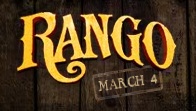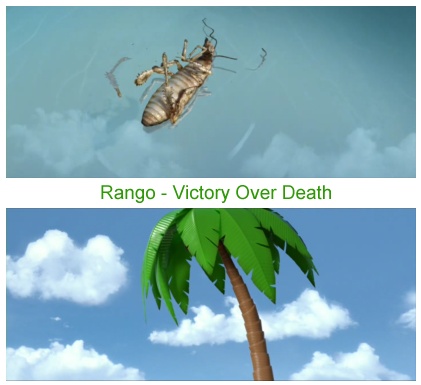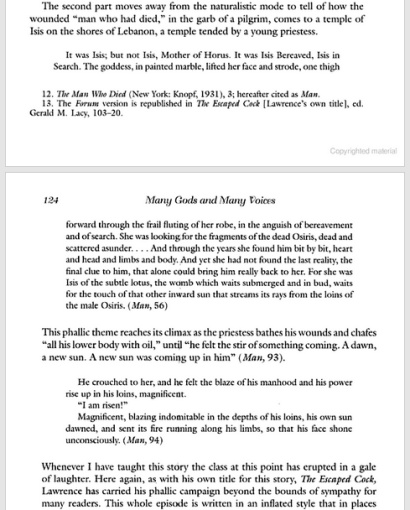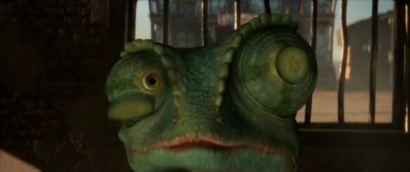 Continuing from the previous post, it should by now be very apparent that Rango is witnessing to a jail break by resurrection. The thespian chameleon's terrarium theater production's script elaborates upon what I noted earlier about this jail break scheme, modeled for us when the mole Balthazar and his underground dwelling kin entered the vertical stream of water and ascended out of their prison cell. The serpent dragon is eager for the 70 generations appointed for the binding of his underground kin to pass. Intensely, passionately eager. This recurring theme is a really big deal.
Continuing from the previous post, it should by now be very apparent that Rango is witnessing to a jail break by resurrection. The thespian chameleon's terrarium theater production's script elaborates upon what I noted earlier about this jail break scheme, modeled for us when the mole Balthazar and his underground dwelling kin entered the vertical stream of water and ascended out of their prison cell. The serpent dragon is eager for the 70 generations appointed for the binding of his underground kin to pass. Intensely, passionately eager. This recurring theme is a really big deal.We must ask at some point where the cryptic elements pointing to Osiris might be found in all of that scene's excessive symbolic death and resurrection messaging. Beyond the obvious featuring of the almost ever-present green-skinned chameleon himself as the green-skinned Osiris, both the dead bug and the palm tree have links to this essential identity.
 Here's the Osiris link with the palm tree. After the chameleon gives his line as the director about acting being reacting, he turns and addresses the palm tree.
Here's the Osiris link with the palm tree. After the chameleon gives his line as the director about acting being reacting, he turns and addresses the palm tree. “Victor, you were wooden. There, I said it.”
Yuk yuk. Of course he is, he's a tree. But here's the Osiris signal. A popular version of the Osiris legend had him encased and preserved inside the acacia tree like a mummy. The acacia is a symbol of eternal life and the hope of resurrection, like the palm tree's victory over death. (Acacia; trees of Ethiopia - SPRIG OF ACACIA - Masonic World) Victor, wooden; Osiris, encased in wood. Palm tree. Acacia. Victor. Osiris. Dot. Dot. Connect.
I've already shown in another post how the doll torso represents Isis. Here they are together on the terrarium stage, Osiris and Isis. Before I move on to the bug's link, here's another that loosely links the palm tree and Osiris but strongly associates the chameleon with Horus-Apollo. According to legend, Apollo was born while his mother Leto clung to a palm tree. Think about it.
By the way, at the base of the palm tree grows some aloe, plants renowned for their healing properties. The tree is all about healing, from death. And, speaking of properties, the acacia are known sources of DMT, a pineal gland and Eye of Horus activating agent used for transdimensional access.
 Now, the bug, Dr. Martz, plays the aging father of the princess, thus, he's a king like King Osiris. He's dead and dismembered, like Osiris. He's floating in the water, like Osiris in the Nile. There's a fish nearby, like the one that ate the phallus of Osiris. Fish eat bugs. That's enough to establish a link, but, ahhh, there's more!
Now, the bug, Dr. Martz, plays the aging father of the princess, thus, he's a king like King Osiris. He's dead and dismembered, like Osiris. He's floating in the water, like Osiris in the Nile. There's a fish nearby, like the one that ate the phallus of Osiris. Fish eat bugs. That's enough to establish a link, but, ahhh, there's more! We know on a few levels why the palm tree is named Victor. Why is the bug played by Dr. Martz? There's a clever clue in this scene and another hint that's dropped in a later scene. Together, they reveal the mysterious identity of Dr. Martz and establish an unmistakable link to Osiris!
 During the dress rehearsal of the mock theatrical production, after the dead bug fails to respond to the hero's threatening sword, the chameleon interrupts the scene, playing the role of acting director.
During the dress rehearsal of the mock theatrical production, after the dead bug fails to respond to the hero's threatening sword, the chameleon interrupts the scene, playing the role of acting director. Dr. Martz. Dr. Martz, I'm not getting anything from you. People, we've talked about this. Acting is reacting.
Who is this Dr. Martz and why does he play the dead bug? In December of 2001, a certain Dr. Martz died, an author and long tenured professor at Yale University. Being dead, he can't very well play a living bug, right? Unless he's raised, of course.
English Professor Louis Martz: 'One of Yale's great teachers'
Please note from that official announcement that he had served as “acting director” for two institutions. Hey - ACTING DIRECTOR? The chameleon actually named Dr. Martz while playing the role of acting director! Well, the professor was not the dramatic acting kind of acting director, but this does effectively serve the purpose of association.
Dr. Martz happened to specialize in English Renaissance literature and 17th-century metaphysical poetry. Hmmmmm. That includes some very layered esoteric literature! Rango featured just such as that in the Elizabethan style terrarium stage production. Rango's Renaissance period drama borrowed the character Malvolio from Twelfth Night, a Shakespearean (Baconian - Sir Francis Bacon) classic. A later scene involved a closely related production put on by Rango's posse as the era's troupe of traveling thespians. We hear Rango deliver this line after he autographs a Bible. "Now remember son, stay in school, eat your veggies and burn everything but Shakespeare." (Burn the Bible?) Assigning Dr. Martz this role in Rango does more than pay homage to the man as a simple cameo might. The point is in the Osiris connection. It's coming.
In another scene, the bank has just been robbed and a character runs through town at dawn, loudly announcing the deed. The stir awakens Sheriff Rango abruptly, who had been in the midst of a dream while sleeping soundly in the jail. He blurts out the following line.
Dr. Martz - I'm on fire - embrace me!
Huh? Is that just a non sequitur outburst from a silly dream, or, comparing to Bean's cryptic but meaningful outbursts on stirring from tonic immobility episodes, a clue providing some insight into why the dead bug was called Dr. Martz? Option 2? Good call!
You can find the telltale text from one of Dr. Martz's books online.
Many Gods and Many Voices: the Role of the Prophet in English and American Modernism by Louis L. Martz
 On page 124, you'll read the professor's critical analysis of the D. H. Laurence story titled The Escaped Cock, where, after presenting a particular excerpt, he writes, “Whenever I have taught this story the class at this point has erupted in a gale of laughter.” I imagine any student who might have fallen asleep in class would have awakened suddenly at the eruption of laughter, like Sheriff Rango. What Rango blurted out makes sense in this context.
On page 124, you'll read the professor's critical analysis of the D. H. Laurence story titled The Escaped Cock, where, after presenting a particular excerpt, he writes, “Whenever I have taught this story the class at this point has erupted in a gale of laughter.” I imagine any student who might have fallen asleep in class would have awakened suddenly at the eruption of laughter, like Sheriff Rango. What Rango blurted out makes sense in this context.The story illustrates the intensity of the pilgrim character's sexual desire poetically using figurative language drawn directly from that used of Osiris, when sought by Isis.
Picture now the dead and dismembered bug as the Osiris of Dr. Martz's commentary on The Escaped Cock. The ready Isis Barbie appeared in the adjacent corner of the set, also dismembered, for NLP association, playing her role as the gravely ill King's daughter. The Isis of legend was the sister of King Osiris, not his daughter, but, hey, that's plenty close enough for NLP.
The next section excerpted from Laurence's story follows.
"I am risen!"
Magnificent, blazing indomitable in the depths of his loins, his own sun dawned, and sent its fire running along his limbs, so that his face shone unconsciously.”
Dr. Martz's reading of the “for mature audiences only” prose that so vividly illustrates an Osiris experience prompted classes of students to erupt in laughter. Any sleeping in the class would surely be startled awake. Rango, startled awake, blurts out: “Dr. Martz - I'm on fire - embrace me!” There it is. There's the knowing reference connecting the dead bug with Osiris.
Any man who has awakened from such a dream feeling “the blaze of his manhood” can relate to what's being further implied here. I'm sure this scene is a source of immense amusement for the few in the know.
This covert reference to Yale University isn't the only one in Rango. You may recall from an earlier post how the Skull and Bones Society at Yale was referenced by the grandfather clock in the banker's office. That clock closely matched the one in the popular picture that shows George Bush standing near the clock.
 The theme of the dawn of the sun god Osiris is unmistakably imported by Rango's clever line, and it may be seen that this is attended by supporting visual imagery. Rango was sleeping with cucumber slices on his eyes, pampering himself and getting his beauty rest while he was supposed to be guarding the bank. When stirred from his erotic dream, the slice covering his right eye fell off immediately, exposing it to us in a Horus identifying visual as Harmerty, Horus who rules with two eyes - Horus on the horizon, awakened, and dawning at sunrise as the incarnation of Osiris, the Beast!
The theme of the dawn of the sun god Osiris is unmistakably imported by Rango's clever line, and it may be seen that this is attended by supporting visual imagery. Rango was sleeping with cucumber slices on his eyes, pampering himself and getting his beauty rest while he was supposed to be guarding the bank. When stirred from his erotic dream, the slice covering his right eye fell off immediately, exposing it to us in a Horus identifying visual as Harmerty, Horus who rules with two eyes - Horus on the horizon, awakened, and dawning at sunrise as the incarnation of Osiris, the Beast! It may be noted that when Rango awoke you can see bars on the window. After waking, he exits immediately. He's free. Hmmmm. This is yet another release from jail by resurrection. It's also another version of the ubiquitous phallic Eye of Horus transformation, right?
If you're able to watch the video of this scene you'll hear a rooster crowing as the sequence begins. The town crier character announcing the theft is pictured at sunrise, running frantically down Main Street. A rooster crows as he begins to yell, “The bank's been robbed! The bank's been robbed! Oh, good Lord, the bank's been robbed!” Hey, where did that rooster in the scene come from? Would that be The Escaped Cock? Apparently so! This adds even more support to the link!
Rango. Have I mentioned yet that it's rich with embedded symbolism?
If we intend to draw some line with Rango to say this here is credible but that there's too much of a stretch, where would we draw it? Let's not underestimate our supernatural adversary's capabilities. One thing we should be taking away from this blog's presentations is that he has woven quite an intricate spell in this world of ours, and we, even immersed in it, have been practically oblivious to it's mechanisms and their working. Another takeaway should be that our Lord Y'shua has these matters well in hand, and you and I, whose eyes He is surely opening! Those of you associated with Rango's production who read here and are still invested in the agendas promoted, make note: It's not yet too late to repent.
So, the palm tree and dead bug both have distinct Osiris connections, with Isis and Horus implicit in the linkings. We know why. Beyond hammering such a simple point home in this series, there's implications made in this valuable intelligence gleaned about the serpent's operations that some of us need to get hold of. How much does the devil know about what's going on now and what's coming? What is the Lord teaching us through this? There's far more that I don't know than what I think I know, but I'm learning.
One item of particular interest to me in the rooster crowing scene is how the devil signals a recognition of the Bride Theft. This resurrection harvest will appear to those left behind as though a theft has occurred. What is most valuable will have been left unguarded and stolen away in the night while they sleep. I wrote about this harvest event at length in a study featured as a Beyond the Veil appendix. The Bride Theft
Here's a couple relevant scriptures.
39) “But be sure of this, that if the head of the house had known at what hour the thief was coming, he would not have allowed his house to be broken into.
40) You too, be ready; for the Son of Man is coming at an hour that you do not expect.”
34) It is like a man away on a journey, who upon leaving his house and putting his slaves in charge, assigning to each one his task, also commanded the doorkeeper to stay on the alert.
35) Therefore, be on the alert—for you do not know when the master of the house is coming, whether in the evening, at midnight, or when the rooster crows, or in the morning—
36) in case he should come suddenly and find you asleep.
37) What I say to you I say to all, ‘Be on the alert!’”
Sheriff Rango was the assigned doorkeeper. Did the master of the house come at midnight, or when the rooster crowed? Notice the words used as the report of the theft was made.
“The bank's been robbed! The bank's been robbed! Oh, good Lord, the bank's been robbed!”
Three times a phrase is repeated. Resurrection. A resurrection robbery. The Bride Theft! Oh, good Lord! Baruch haba b'shem Adonai! Blessed is he who comes in the name of the Lord!
There are four phrases. Three are the same. It's another instance of “three things and then four,” another signal expression of the 4th Shemittah from 1991's sign being the season appointed for these events to be fulfilled.
The bank robbery was a key trigger that changed the course of the story in Rango. Not unlike the Bride Theft. Watch and see.

No comments:
Post a Comment